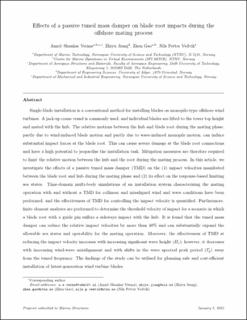| dc.contributor.author | Verma, Amrit Shankar | |
| dc.contributor.author | Jiang, Zhiyu | |
| dc.contributor.author | Gao, Zhen | |
| dc.contributor.author | Vedvik, Nils Petter | |
| dc.date.accessioned | 2021-02-12T12:15:50Z | |
| dc.date.available | 2021-02-12T12:15:50Z | |
| dc.date.created | 2020-11-11T17:12:43Z | |
| dc.date.issued | 2020 | |
| dc.identifier.citation | Marine Structures. 2020, 72 . | en_US |
| dc.identifier.issn | 0951-8339 | |
| dc.identifier.uri | https://hdl.handle.net/11250/2727750 | |
| dc.description.abstract | Single-blade installation is a conventional method for installing blades on monopile-type offshore wind turbines. A jack-up crane vessel is commonly used, and individual blades are lifted to the tower top height and mated with the hub. The relative motions between the hub and blade root during the mating phase, partly due to wind-induced blade motion and partly due to wave-induced monopile motion, can induce substantial impact forces at the blade root. This can cause severe damage at the blade root connections and have a high potential to jeopardise the installation task. Mitigation measures are therefore required to limit the relative motion between the hub and the root during the mating process. In this article, we investigate the effects of a passive tuned mass damper (TMD) on the (1) impact velocities manifested between the blade root and hub during the mating phase and (2) its effect on the response-based limiting sea states. Time-domain multi-body simulations of an installation system characterising the mating operation with and without a TMD for collinear and misaligned wind and wave conditions have been performed, and the effectiveness of TMD for controlling the impact velocity is quantified. Furthermore, finite element analyses are performed to determine the threshold velocity of impact for a scenario in which a blade root with a guide pin suffers a sideways impact with the hub. It is found that the tuned mass damper can reduce the relative impact velocities by more than 40% and can substantially expand the allowable sea states and operability for the mating operation. Moreover, the effectiveness of TMD at reducing the impact velocity increases with increasing significant wave height (); however, it decreases with increasing wind-wave misalignment and with shifts in the wave spectral peak period () away from the tuned frequency. The findings of the study can be utilised for planning safe and cost-efficient installation of latest-generation wind turbine blades. | en_US |
| dc.language.iso | eng | en_US |
| dc.publisher | Elsevier | en_US |
| dc.rights | Attribution-NonCommercial-NoDerivatives 4.0 Internasjonal | * |
| dc.rights.uri | http://creativecommons.org/licenses/by-nc-nd/4.0/deed.no | * |
| dc.title | Effects of a Passive Tuned Mass Damper on Blade Root Impacts During the Offshore Mating Process | en_US |
| dc.type | Peer reviewed | en_US |
| dc.type | Journal article | en_US |
| dc.description.version | acceptedVersion | en_US |
| dc.source.pagenumber | 26 | en_US |
| dc.source.volume | 72 | en_US |
| dc.source.journal | Marine Structures | en_US |
| dc.identifier.doi | 10.1016/j.marstruc.2020.102778 | |
| dc.identifier.cristin | 1847099 | |
| dc.relation.project | Norges forskningsråd: 237929 | en_US |
| dc.description.localcode | "© 2020. This is the authors’ accepted and refereed manuscript to the article. Locked until 5.5.2022 due to copyright restrictions. This manuscript version is made available under the CC-BY-NC-ND 4.0 license http://creativecommons.org/licenses/by-nc-nd/4.0/ " | en_US |
| cristin.ispublished | true | |
| cristin.fulltext | postprint | |
| cristin.qualitycode | 2 | |

